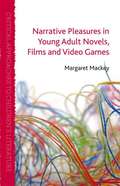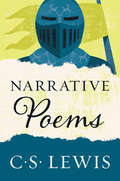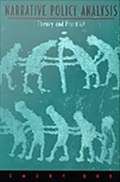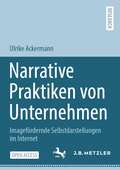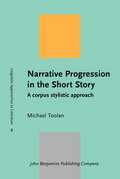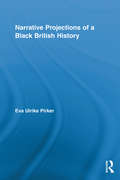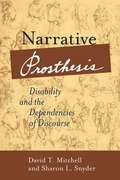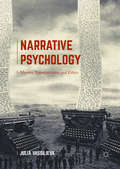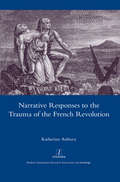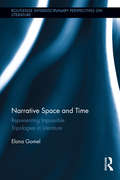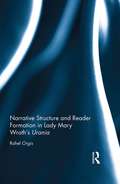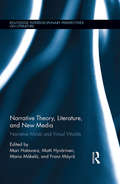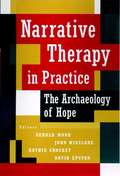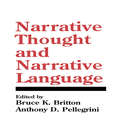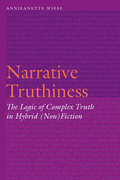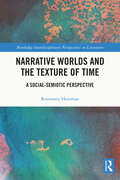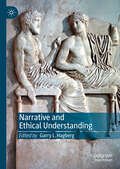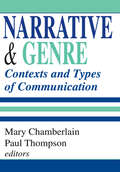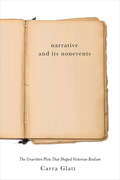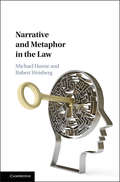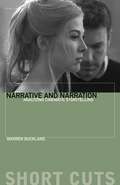- Table View
- List View
Narrative Pleasures in Young Adult Novels, Films, and Video Games
by Margaret MackeyStories are told today through many formats and young interpreters bring multimedia experience to bear on every narrative format they encounter. In this book, twelve young people read a novel, watch a film and play a video game from beginning to end. Their responses inform a new framework of contemporary themes of narrative comprehension.
Narrative Poems
by C. S. LewisA repackaged edition of the revered author’s collection of four poems: "Dymer," "Launcelot," "The Nameless Isle," and "The Queen of Drum."C. S. Lewis—the great British writer, scholar, lay theologian, broadcaster, Christian apologist, and author of Mere Christianity, The Screwtape Letters, The Great Divorce, The Chronicles of Narnia, and many other beloved classics—was also a talented poet. In this collection of four longer works of verse, Lewis displays his deep love for medieval and Renaissance poetry and themes, influences that shaped—and resonate through—his fiction.
Narrative Policy Analysis
by Practice TheoryNarrative Policy Analysis presents a powerful and original application of contemporary literary theory and policy analysis to many of today's most urgent public policy issues. Emery Roe demonstrates across a wide array of case studies that structuralist and poststructuralist theories of narrative are exceptionally useful in evaluating difficult policy problems, understanding their implications, and in making effective policy recommendations. Assuming no prior knowledge of literary theory, Roe introduces the theoretical concepts and terminology from literary analysis through an examination of the budget crises of national governments. With a focus on several particularly intractable issues in the areas of the environment, science, and technology, he then develops the methodology of narrative policy analysis by showing how conflicting policy "stories" often tell a more policy-relevant meta-narrative. He shows the advantage of this approach to reading and analyzing stories by examining the ways in which the views of participants unfold and are told in representative case studies involving the California Medfly crisis, toxic irrigation in the San Joaquin Valley, global warming, animal rights, the controversy over the burial remains of Native Americans, and Third World development strategies. Presenting a bold innovation in the interdisciplinary methodology of the policy sciences, Narrative Policy Analysis brings the social sciences and humanities together to better address real-world problems of public policy--particularly those issues characterized by extreme uncertainty, complexity, and polarization--which, if not more effectively managed now, will plague us well into the next century.
Narrative Praktiken von Unternehmen: Imagefördernde Selbstdarstellungen im Internet
by Ulrike AckermannDiese Open-Access-Publikation befasst sich mit dem Erzählen im Unternehmenskontext, was spätestens seit der Einführung des Storytelling in den 1999er-Jahren allgegenwärtig ist. Der Band zeigt in diesem Zusammenhang, wie Unternehmen das Erzählen explizit im Internet nutzen, um sich nach außen positiv darzustellen (= Imageförderung). In der Veröffentlichung wird deutlich, dass für die (Selbst)Darstellung bestimme Spezifika von Erzählungen von besonderer Bedeutung sind. Mit ihrer Hilfe können Unternehmen bspw. Konzepte – wie Corporate Responsibility – als gelebte Werte den Zielgruppen diskret veranschaulichen oder den Arbeitsalltag zu einem besonderen Erlebnis stilisieren. Insgesamt identifiziert die Autorin vier Grundtypen der (Selbst)Darstellung mit jeweils spezifisch narrativer Rhetorik sowie bezeichnende narrative Realisierungsformen, um diese Typen im WWW an die gewünschten Zielgruppen zu kommunizieren. Hierbei zeichnen sich die sprachwissenschaftlich analysierten Erkenntnisse durch ihre interdisziplinäre Einbettung aus. Dadurch eröffnen sich Anschlussmöglichkeiten zu anderen Fachdisziplinen.
Narrative Progression in the Short Story: A corpus stylistic approach
by Michael ToolanOne of our most valuable capacities is our ability partly to predict what will come next in a text. But linguistic understanding of this remains very limited, especially in genres such as the short story where there is a staging of the clash between predictability and unpredictability. This book proposes that a matrix of narrativity-furthering textual features is crucial to the reader’s forming of expectations about how a literary story will continue to its close. Toolan uses corpus linguistic software and methods, and stylistic and narratological theory, in the course of delineating the matrix of eight parameters that he sees as crucial to creating narrative progression and expectation. The book will be of interest to stylisticians, narratologists, corpus linguists, and short story scholars.
Narrative Projections of a Black British History (Routledge Approaches to History)
by Eva Ulrike PirkerSince the mid-1990s, the black experience in Britain has begun to be (re)negotiated intensely, with a strong focus on history. Narrative Projections of a Black British History considers narratives that construct, or engage with, aspects of a black British history. Part I poses the question of what sort of narratives have emerged from, and in turn determine, key events (such as the iconic 'Windrush' moment) and developments and provides basic insights into theoretical frameworks. It also offers a large number of comparative readings, considering both 'factual' and 'fictional' forms of representation such as history books, documentary films, life writing, novels, and drama, and identifies main strands, 'official' narratives and countercurrents. Part II embarks on close readings and analyses of a selection of narratives that can be classed as reactions to the 'established' historical culture. Overall, the book draws attention to collective currents and individual positions, affirmative and critical approaches: Together, they form a representative image of a specific moment in the ongoing debate about a black British history.
Narrative Prosthesis: Disability and the Dependencies of Discourse
by David T. Mitchell Sharon L. SnyderNarrative Prosthesis: Disability and the Dependencies of Discourse develops a narrative theory of the pervasive use of disability as a device of characterization in literature and film. It argues that, while other marginalized identities have suffered cultural exclusion due to a dearth of images reflecting their experience, the marginality of disabled people has occurred in the midst of the perpetual circulation of images of disability in print and visual media. The manuscript's six chapters offer comparative readings of key texts in the history of disability representation, including the tin soldier and lame Oedipus, Montaigne's "infinities of forms" and Nietzsche's "higher men," the performance history of Shakespeare's Richard III, Melville's Captain Ahab, the small town grotesques of Sherwood Anderson's Winesburg, Ohio and Katherine Dunn's self-induced freaks in Geek Love. David T. Mitchell is Associate Professor of Literature and Cultural Studies, Northern Michigan University. Sharon L. Snyder is Assistant Professor of Film and Literature, Northern Michigan University.
Narrative Psychology
by Julia VassilievaThis book provides the first comparative analysis of thethree major streams of contemporary narrative psychology as they have beendeveloped in North America, Europe, and Australia and New Zealand. Interrogating the historical and cultural conditions in which this importantmovement in psychology has emerged, the book presents clear, well-structuredcomparisons and critique of the key theories of narrative psychology pioneeredacross the globe. Examples include Dan McAdams in the US and his followers, whohave developed a distinctive approach to self and identity as a life story overthe past two decades; in the Netherlands by Hubert Hermans, whose research onthe 'dialogical self' has made the University of Nijmegen a centre of narrativepsychological research in Europe; and in Australia and New Zealand, where thecollaborative efforts of Michael White and David Epston helped to launch thenarrative movement in psychotherapy in the late 1980s.
Narrative Pulse of Beowulf
by John M HillOne of the most consistent critiques levelled against Beowulf is that it lacks a steady narrative advance and that its numerous digressions tend to complicate if not halt the poem's movement. As those passages often look backward or far ahead in narrative time, they seem to transform the poem into a meditative pastiche. The Narrative Pulse of Beowulf counters this assertion, examining Beowulf as a social drama with a strong, forward-moving narrative momentum.John M. Hill discerns a distinctive 'narrative pulse' arising out of the poem's many scenes of arrival and departure. He argues that such scenes, far from being fixed or 'type' scenes, are socially dramatic and a key to understanding the structural density of the poem. Bolstering his analysis with a strong understanding of the epic, Hill looks at Beowulf in relation to other stories such as The Odyssey and The Iliad, epics that, though they may appear to have a certain narrative elasticity, use scenes of arrival and departure to create a cohesive social world in which stories unfold. As a new and comprehensive study of one of the most important Old English texts, The Narrative Pulse of Beowulf sheds new light on this famous poem and the epic tradition itself.
Narrative Responses to the Trauma of the French Revolution
by Katherine AstburyDuring the French Revolution, traditional literary forms such as the sentimental novel and the moral tale dominate literary production. At first glance, it might seem that these texts are unaffected by the upheavals in France; in fact they reveal not only a surprising engagement with politics but also an internalised emotional response to the turbulence of the period. In this innovative and wide-ranging study, Katherine Astbury uses trauma theory as a way of exploring the apparent contradiction between the proliferation of non-political literary texts and the events of the Revolution. Through the narratives of established bestselling literary figures of the Ancien Regime (primarily Marmontel, Madame de Genlis and Florian), and the early works of first generation Romantics Madame de Stael and Chateaubriand, she traces how the Revolution shapes their writing, providing an intriguing new angle on cultural production of the 1790s.Katherine Astbury is Senior Lecturer in French Studies at the University of Warwick.
Narrative Space and Time: Representing Impossible Topologies in Literature (Routledge Interdisciplinary Perspectives on Literature)
by Elana GomelSpace is a central topic in cultural and narrative theory today, although in most cases theory assumes Newtonian absolute space. However, the idea of a universal homogeneous space is now obsolete. Black holes, multiple dimensions, quantum entanglement, and spatio-temporal distortions of relativity have passed into culture at large. This book examines whether narrative can be used to represent these "impossible" spaces. Impossible topologies abound in ancient mythologies, from the Australian Aborigines’ "dream-time" to the multiple-layer universe of the Sumerians. More recently, from Alice’s adventures in Wonderland to contemporary science fiction’s obsession with black holes and quantum paradoxes, counter-intuitive spaces are a prominent feature of modern and postmodern narrative. With the rise and popularization of science fiction, the inventiveness and variety of impossible narrative spaces explodes. The author analyses the narrative techniques used to represent such spaces alongside their cultural significance. Each chapter connects narrative deformation of space with historical problematic of time, and demonstrates the cognitive and perceptual primacy of narrative in representing, imagining and apprehending new forms of space and time. This book offers a comprehensive analysis of the connection between narratology, cultural theory, science fiction, and studies of place.
Narrative Structure and Reader Formation in Lady Mary Wroth's Urania
by Rahel OrgisNarrative Structure and Reader Formation in Lady Mary Wroth’s Urania offers the first systematic formal and thematic analysis of Wroth’s Urania in its historical context and explores the structural means by which Wroth fashions her readership. The book thus has a dual focus, at once on narrative art and reader formation. It makes two original claims, the first being that the Urania is not the unorganized accumulation of stories critics have tended to present it as, but a work of sophisticated narrative structures i.e. a complex text in a positive sense. These structures are revealed by means of a circumspect narratological analysis of the formal and thematic patterns that organise the Urania. Such an analysis furthers our understanding of the reading strategies that Wroth encourages. The second claim is, then, that through the careful structuring of her text Wroth seeks to create her own ideal readership. More precisely, the formal and thematic structures of the Urania engage with readers’ expectations, inviting them to reflect on prominent thematic issues and respond to the text as what early modern prefaces term "good" readers. Combining narratological methods with a generic perspective and taking into account the work of book historians on early modern reading practices, this monograph provides a new approach to the Urania, supplementing the typically gender- or (auto)biographically-oriented interpretations of the romance. Moreover, it contributes to the study of early modern (prose) narrative and romance and exemplifies how historically contextualised narratological analysis may yield new insights and profit research on reading strategies.
Narrative Theory
by Kent PuckettKent Puckett's Narrative Theory: A Critical Introduction provides an account of a methodology increasingly central to literary studies, film studies, history, psychology and beyond. In addition to introducing readers to some of the field's major figures and their ideas, Puckett situates critical and philosophical approaches towards narrative within a longer intellectual history. The book reveals one of narrative theory's founding claims - that narratives need to be understood in terms of a formal relation between story and discourse, between what they narrate and how they narrate it - both as a necessary methodological distinction and as a problem characteristic of modern thought. Puckett thus shows that narrative theory is not only a powerful descriptive system but also a complex and sometimes ironic form of critique. Narrative Theory offers readers an introduction to the field's key figures, methods and ideas, and it also reveals that field as unexpectedly central to the history of ideas.
Narrative Theory, Literature, and New Media: Narrative Minds and Virtual Worlds (Routledge Interdisciplinary Perspectives on Literature)
by Mari Hatavara Matti Hyvärinen Maria Mäkelä Frans MäyräOffering an interdisciplinary approach to narrative, this book investigates storyworlds and minds in narratives across media, from literature to digital games and reality TV, from online sadomasochism to oral history databases, and from horror to hallucinations. It addresses two core questions of contemporary narrative theory, inspired by recent cognitive-scientific developments: what kind of a construction is a storyworld, and what kind of mental functioning can be embedded in it? Minds and worlds become essential facets of making sense and interpreting narratives as the book asks how story-internal minds relate to the mind external to the storyworld, that is, the mind processing the story. With essays from social scientists, literary scholars, linguists, and scholars from interactive media studies answering these topical questions, the collection brings diverse disciplines into dialogue, providing new openings for genuinely transdisciplinary narrative theory. The wide-ranging selection of materials analyzed in the book promotes knowledge on the latest forms of cultural and social meaning-making through narrative, necessary for navigating the contemporary, mediatized cultural landscape. The combination of theoretical reflection and empirical analysis makes this book an invaluable resource for scholars and advanced students in fields including literary studies, social sciences, art, media, and communication.
Narrative Therapy in Practice: The Archaeology of Hope
by Gerald Monk Kathie Crocket David Epston John WinsladeHow to apply the definitive postmodern therapeutic technique in a variety of situations, including treating alcoholics, counseling students, treating male sexual abuse survivors, and more. Written with scholarship, energy, practicality, and awareness.
Narrative Thought and Narrative Language (Cog Studies Grp of the Inst for Behavioral Research at UGA)
by Bruce K. Britton A. D. PellegriniSince before the dawn of history, people have been telling stories to each other and to themselves. Thus stories are at the root of human experience. This volume describes empirical investigations by Jerome Bruner, Wallace Chafe, David Olson, and others on the relationship between stories and cognition. Using philosophical, linguistic, anthropological, and psychological perspectives on narrative, the contributors provide a definitive, highly diversified portrait of human cognition.
Narrative Traditions in International Politics: Representing Turkey (The Palgrave Macmillan Series in International Political Communication)
by Johanna VuorelmaThis book introduces the concept of narrative tradition to study representation in international politics. Focusing specifically on the case of Turkey, the book shows how narrative traditions are constructed, maintained, and passed on by a loose epistemic community that involves practitioners and experts including scholars, journalists, diplomats, and political representatives. Employing an interpretative approach, the book distinguishes between four narrative traditions in the study of Turkey: Turkey as a state that is (1) getting lost, (2) standing at a decisive crossroad, (3) led by strongmen, and (4) struggling with a creeping Islamisation.These narrative traditions carry enduring beliefs that not only describe, moralise, judge, and stigmatise Turkey, but also contribute to the idea of the West. The book focuses on knowledge that is produced from a Western perspective, showing that Turkey provides a channel through which the Western self can be debated, challenged, celebrated, and judged.
Narrative Truthiness: The Logic of Complex Truth in Hybrid (Non)Fiction (Frontiers of Narrative)
by Annjeanette WieseNarrative Truthiness explores the complex nature of truth by adapting Stephen Colbert&’s concept of truthiness (which on its own repudiates complexity) into something nuanced and positive, what Annjeanette Wiese calls &“narrative truthiness.&” Narrative truthiness holds on to the importance of facts while complicating them by looking at different types of truth, as well as the complexity, contradictions, and consequences of truth in the context of human experience. Wiese uses narrative theory to analyze several examples of hybrid (non)fiction: works that refuse to exist as either fiction or nonfiction alone and that challenge monolithic definitions of truth. She examines memoirs by Lauren Slater, Michael Ondaatje, Binjamin Wilkomirski, Tim O&’Brien; fiction by Julian Barnes, Richard Powers, W. G. Sebald; Onion headlines; comics and graphic memoirs by Joe Sacco, Art Spiegelman, and David Small; and fake news.Narrative Truthiness foregrounds the complexity that is inherent in human understanding and experience and in the process demonstrates the significance of the complex tensions between what we feel to be true and what is true, and how we are shaped by both.
Narrative Worlds and the Texture of Time: A Social-Semiotic Perspective (Routledge Interdisciplinary Perspectives on Literature)
by Rosemary HuismanThis book brings together a model of time and a model of language to generate a new model of narrative, where different stories with different temporalities and non-chronological modes of sequence can tell of different worlds of human – and non-human – experience, woven together (the ‘texture of time’) in the one narrative. The work of Gerald Edelman on consciousness, J.T. Fraser on time, and M.A.K. Halliday on language is introduced; the categories of systemic functional linguistics are used for detailed analysis of English narrative texts from different literary periods. A summary chapter gives an overview of previous narrative studies and theories, with extensive references. Chapters on ‘temporalization’ and ‘spatialization’ of language contrast the importance of time in narrative texts with the effect of ‘grammatical metaphor’, as described by M.A.K. Halliday, for scientific discourse. Chapters on prose fiction, poetry and the texts of digital culture chart changes in the ‘texture of time’ with changes in the social context: ‘narrative as social semiotic’.
Narrative Worlds and the Texture of Time: A Social-Semiotic Perspective (Routledge Interdisciplinary Perspectives on Literature)
by Rosemary HuismanThis book brings together a model of time and a model of language to generate a new model of narrative, where different stories with different temporalities and non-chronological modes of sequence can tell of different worlds of human – and non-human – experience, woven together (the ‘texture of time’) in the one narrative. The work of Gerald Edelman on consciousness, J.T. Fraser on time, and M.A.K. Halliday on language is introduced; the categories of systemic functional linguistics are used for detailed analysis of English narrative texts from different literary periods. A summary chapter gives an overview of previous narrative studies and theories, with extensive references. Chapters on ‘temporalization’ and ‘spatialization’ of language contrast the importance of time in narrative texts with the effect of ‘grammatical metaphor’, as described by M.A.K. Halliday, for scientific discourse. Chapters on prose fiction, poetry and the texts of digital culture chart changes in the ‘texture of time’ with changes in the social context: ‘narrative as social semiotic’.
Narrative and Ethical Understanding
by Garry L. HagbergThere has been a steady stream of articles written on the relations between ethics and the interpretation of literature, but there remains a need for a book that both introduces and significantly contributes to the field – particularly one that shows how we can think more openly and creatively about the multiform powers of ethical narrative by considering ethically significant literature. This volume offers an analytically acute and culturally rich way of understanding how it is that we can productively think philosophically about the narrative structures that describe our ethical lives and what kind of distinctive conceptual, and in some cases personal, progress we can make by doing so. Given the extremely widespread interest in ethical issues, this volume will strike resonant chords far and wide on arrival, while offering something new in bringing together the study of long-form narrative, the language of moral psychology, and detailed literary case studies. Given the vast expansion of narrative studies in recent years, the time for just such a volume is right.
Narrative and Genre: Contexts and Types of Communication (Routledge Studies In Memory And Narrative Ser. #Vol. 1)
by Paul Thompson Mary ChamberlainAny life story, whether a written autobiography or an oral testimony, is shaped not only by the reworkings of experience through memory and re-evaluation, but also by art. Any communication has to use shared conventions not only of language itself, but also the more complex expectations of ""genre,"" the forms expected within a given context and type of communication. This collection of essays by international academics draws on a wide range of disciplines in the social sciences and the humanities to examine how far the expectations and forms of genre shape different kinds of autobiography and influence what messages they can convey. After investigating the problem of genre definition, and tracing the evolution of genre as a concept, contributors explore such issues as: How far can we argue that what people narrate in their autobiographical stories is selected and shaped by the repertoire of genre available to them? To what extent is oral autobiography shaped by its social and cultural context? What is the relationship between autobiographical sources and the ethnographer? Narrative and Genre presents exciting new debates in an emerging field and will encourage international and interdisciplinary discussion. Its authors and contributors are scholars from the fields of anthropology, cultural studies, literary analysis, psychology, psychoanalysis, social history, and sociology.
Narrative and Its Nonevents: The Unwritten Plots That Shaped Victorian Realism (Victorian Literature and Culture Series)
by Carra GlattThis book is about what does not happen in the Victorian novel. The description may sound absurd, yet consideration of alternatives to a given state of affairs is crucial to our understanding of a novel. Plot emerges out of the gradual elimination of possibilities, from the revelation, on the first page of a work, that we are in nineteenth-century London and not sixteenth-century Paris, to the final disclosure that Pip returns home too late to marry Biddy but is now free to pursue his lost love Estella.Through careful examination of the plots of such classics as Charles Dickens’s Great Expectations, Charlotte Brontë’s Villette, Wilkie Collins’s The Moonstone, Jane Austen’s Pride and Prejudice, Henry James’s The Ambassadors, Elizabeth Gaskell’s Mary Barton, and others, Glatt argues for the central role of these "unwritten plots" in Victorian narrative construction. Abandoning the allegorical mode—in which characters are bound by fixed identities to reach a predetermined conclusion—and turning away from classical and historical plots with outcomes already known to audiences, the realist novel of the Victorian era was designed to simulate the openness and uncertainty of ordinary human experience. We are invested in these stories of David Copperfield or Elizabeth Bennet or Lucy Snowe in part because we cannot be entirely sure how those stories will end. As Glatt demonstrates, the Victorian novel is characterized by a proliferation of possibilities.
Narrative and Metaphor in the Law
by Robert Weisberg Michael HanneIt has long been recognized that court trials, both criminal and civil, in the common law system, operate around pairs of competing narratives told by opposing advocates. In recent years, however, it has increasingly been argued that narrative flows in many directions and through every form of legal theory and practice. Interest in the part played by metaphor in the law, including metaphors for the law, and for many standard concepts in legal practice, has also been strong, though research under the metaphor banner has been much more fragmentary. In this book, for the first time, a distinguished group of legal scholars, collaborating with specialists from cognitive theory, journalism, rhetoric, social psychology, criminology, and legal activism, explore how narrative and metaphor are both vital to the legal process. Together, they examine topics including concepts of law, legal persuasion, human rights law, gender in the law, innovations in legal thinking, legal activism, creative work around the law, and public debate around crime and punishment.
Narrative and Narration: Analyzing Cinematic Storytelling (Short Cuts)
by Warren BucklandFrom mainstream blockbusters to art house cinema, narrative and narration are the driving forces that organize a film. Yet attempts to explain these forces are often mired in notoriously complex terminology and dense theory. Warren Buckland provides a clear and accessible introduction that explains how narrative and narration work using straightforward language.Narrative and Narration distills the basic components of cinematic storytelling into a set of core concepts: narrative structure, processes of narration, and narrative agents. The book opens with a discussion of the emergence of narrative and narration in early cinema and proceeds to illustrate key ideas through numerous case studies. Each chapter guides readers through different methods that they can use to analyze cinematic storytelling. Buckland also discusses how departures from traditional modes, such as feminist narratives, art cinema, and unreliable narrators, can complicate and corroborate the book’s understanding of narrative and narration. Examples include mainstream films, both classic and contemporary; art house films of every stripe; and two relatively new styles of cinematic storytelling: the puzzle film and those driven by a narrative logic derived from video games. Narrative and Narration is a concise introduction that provides readers with fundamental tools to understand cinematic storytelling.
